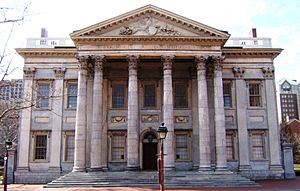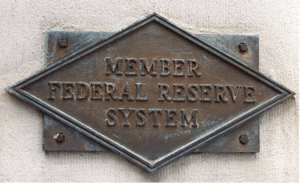Banking in the United States facts for kids
Banking in the United States started in the 1780s, around the time the country was founded. It has grown into a very important and complex system of banks and financial services. This system helps people and businesses manage their money. Major financial services include managing money for others and making sure deposits are safe. New York City and Wall Street are key centers for this industry.
The first banks appeared in 1780. The Bank of Pennsylvania was created to help fund the American Revolutionary War. Later, the Bank of North America opened. It helped merchants in the Thirteen Colonies with more advanced money transactions. Before this, people often used informal trade instead of a clear currency.
As of 2018, some of the biggest banks in the U.S. were JPMorgan Chase, Bank of America, Wells Fargo, Citigroup, and Goldman Sachs. The total value of money held by banks was about 56 percent of the entire U.S. economy. In 2021, there were nearly 5,000 commercial banks and savings institutions in the country.
Contents
History of Banking in the U.S.
Merchants from Britain helped start the Bank of Pennsylvania in 1780. This bank helped pay for the American Revolutionary War (1775–1783). At that time, the Thirteen Colonies did not have a strong national currency. People often traded goods instead of using money.
On January 4, 1782, the Bank of North America opened. It was the first commercial bank in the U.S. In 1791, U.S. Treasury Secretary Alexander Hamilton created the Bank of the United States. This was a national bank. Its job was to manage American taxes and help pay off foreign debts.
President Andrew Jackson closed this national bank in 1832. He moved all its money into banks run by the different U.S. states. These state banks then started printing a lot of money. This caused prices to rise very quickly, leading to a financial crisis called the Panic of 1837.
Later, in the 1860s, investment banking began. This is where banks help companies and governments raise money. The National Bank Act was passed in 1863. This law created a national currency and a federal banking system. It also made it easier for banks to give out public loans.
In 1913, the Federal Reserve was created. This system helps control the nation's money supply. During the Great Depression, a law called the Glass-Steagall Act was passed. It separated regular banking (like checking accounts) from investment banking. This law was later removed in 1991. Some people believe this change contributed to the 2008 financial crisis.
Who Regulates Banks?
Most countries have one main bank regulator. But in the U.S., banks are regulated by both federal (national) and state governments. This means a bank might follow rules from many different agencies. U.S. banking rules cover things like protecting your privacy and preventing fraud. They also work to stop money laundering and promote lending to people with lower incomes.
The Federal Reserve System
The Federal Reserve System is the central bank of the United States. It was created in 1913 after several financial panics, especially a big one in 1907. Over time, the Federal Reserve's jobs have grown.
Today, its main duties are:
- Controlling the nation's money supply.
- Watching over and regulating banks.
- Keeping the financial system stable.
- Providing financial services to banks and the U.S. government.
Federal Deposit Insurance Corporation (FDIC)
The Federal Deposit Insurance Corporation (FDIC) is a U.S. government agency. It was created in 1933. The FDIC provides deposit insurance. This means it guarantees the money you put in a member bank is safe. If a bank fails, the FDIC will pay you back up to $250,000 per person per bank.
As of 2010, the FDIC insured deposits at 6,800 banks. The FDIC also checks banks to make sure they are safe and sound. Since the FDIC started insuring deposits in 1934, no one has lost insured money because a bank failed.
Office of the Comptroller of the Currency (OCC)
The Office of the Comptroller of the Currency (OCC) is a U.S. federal agency. It was started in 1863. The OCC's job is to approve, regulate, and supervise all national banks. It also oversees the U.S. branches of foreign banks.
Consumer Financial Protection Bureau (CFPB)
The Consumer Financial Protection Bureau (CFPB) is another important agency. It works to protect consumers in the financial marketplace. This includes making sure banks treat customers fairly.
Types of Banks
Banks in the United States can get different types of licenses, called charters. The type of charter a bank has affects which agencies oversee it.
National Bank
A national bank has a federal charter. This means it can operate in any state across the country. One advantage for national banks is that they are not always subject to state laws that limit interest rates. This means they can sometimes offer different loan terms. A national bank's name must include "National" or "N.A." (for National Association).
State Bank
A state bank has a state charter. This means it was formed under the laws of a specific state government. Historically, state banks could only operate in the state where they were chartered. However, this rule has changed. Since 2010, state-chartered banks can now open branches in any other state. A state bank cannot have "National" or "Federal" in its name.
State Non-Member Bank
These are state-chartered banks that are not part of the Federal Reserve System. However, they are still overseen by the FDIC, which protects your deposits.
Federal Savings Association
Federal savings associations (FSAs) include federal savings banks (FSBs). They were created in 1933. While they used to focus mainly on home loans, they now offer a wider range of banking services. They have different rules from national banks. For example, they can invest directly in real estate.
State Savings Association
These are similar to federal savings associations but are registered under state law. They are also overseen by the FDIC.
Bank Mergers and Closures
Banks often merge for many reasons. Sometimes, two banks combine to create a larger bank. This can help them save money by streamlining operations. Other times, a bank might buy another bank to get its customers or brands.
Banks can also be closed by regulators. This happens if a bank is not managing its money safely or does not have enough funds. Banks cannot go bankrupt in the United States in the same way other businesses can. This is because the FDIC insures customer deposits up to $250,000.
If a bank is in danger of failing, the FDIC usually takes it over. The FDIC then temporarily manages the bank. After that, the bank is either sold to another bank or merged with one. The FDIC keeps a list of banks that have been taken over by regulators.
Banking Privacy
In the United States, your banking privacy is protected by several laws. There isn't one single law that covers everything. One important federal law is the Gramm-Leach-Bliley Act (GLB). This law controls how banks collect, share, and use your private information.
The Federal Trade Commission (FTC) also helps protect banking privacy. It can fine banks that break privacy laws. Unlike some other countries, breaking banking privacy rules in the U.S. is usually a civil offense, not a criminal one.
List of Banks
As of 2014, there were nearly 6,800 banks in the United States insured by the FDIC. This includes all banks that are part of the Federal Reserve System, as well as other banks insured by the FDIC. In 2011, the five largest banks by total money managed were JPMorgan Chase, Bank of America, Citigroup, Wells Fargo, and Goldman Sachs.
Images for kids




